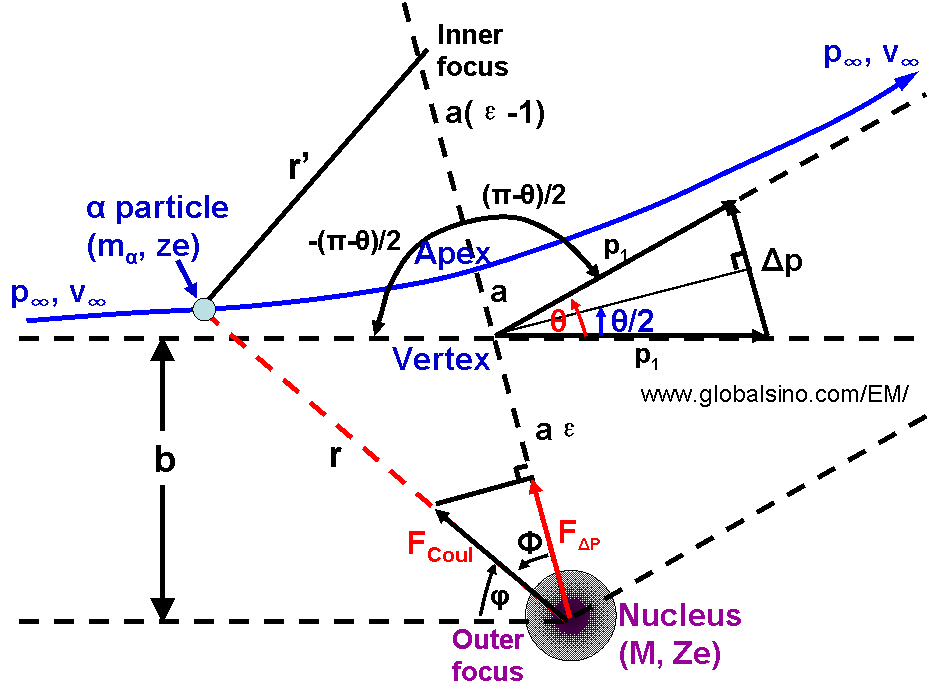=================================================================================
The model of Rutherford scattering of α particles on gold nuclei was based on four assumptions: i) The gold nucleus mass (M) is much larger than the α particle mass mα (M >> mα); ii) Scattering of α particles on atomic electrons is negligible because mα >> me (me is the electron mass); iii) The α particle does not penetrate the nucleus (meaning no nuclear reactions); iv) The classical relationship for the kinetic energy EK of the α particle (EK = mαυ2/2) is valid (υ is the velocity of the α particle).
When the α particle (positive charge ze) approaches the nucleus (positive charge Ze) the interaction between them is a repulsive Coulomb interaction, and thus, the α particle follows a hyperbolic trajectory, as shown in Figure 4417. The nucleus is in the outer focus of the hyperbola because of the repulsive interaction. The relationship between the impact parameter b and the scattering angle θ may be derived by determining two independent expressions for the change in momentum Δp of the scattered α particle. υ∞ is the initial velocity of the α particle and p∞ is the initial momentum of the α
particle. The momentum transfer is along a line that bisects the angle π − θ. The magnitude of the Coulomb force Fcoul acting on
the α particle is given by,
 ------------------------------------ [4417a] ------------------------------------ [4417a]
where,
r -- The distance between the α particle and the nucleus M
z -- The atomic number of the α particle (for helium z = 2)
Z -- The atomic number of the absorber (for gold Z = 79)

Figure 4417. Schematic diagram for scattering of an α particle on a nucleus.
The momentum transfer Δp is given by,
 ------------------------------------ [4417b] ------------------------------------ [4417b]
The impact parameter b may be written as,
 ----------------------------------------- [4417c] ----------------------------------------- [4417c]
In HAADF STEM, the "high-angle" means beyond the angle at which diffraction maxima (spots) can be found. High-angle scattered electrons are few in number of elections and are mostly induced by Rutherford scattering.
Table 4417 shows that electrons interact with 1 electron, many electrons, 1 nucleus, and many nuclei in solids.
Table 4417. Effects of interactions of electrons in solids.
| |
Interaction with electron(s) |
Interaction with nucleus/nuclei |
| |
1 electron |
Many electrons |
1 nucleus |
Many nuclei |
| Scattering type |
Inelastic |
Inelastic |
Quasi-elastic |
Elastic |
Inelastic |
| Scattering effect |
Electron Compton effect; electron excitation (from 50 eV to a few keV: EDS and EELS) |
Plasmon excitation (< 50 eV, ~100 nm TEM specimen); Cerenkov effect |
Rutherford scattering; phonon scattering (< 1 eV, heat) |
Bragg scattering |
Bremsstrahlung |
|
 ------------------------------------ [4417a]
------------------------------------ [4417a] 
 ----------------------------------------- [4417c]
----------------------------------------- [4417c]